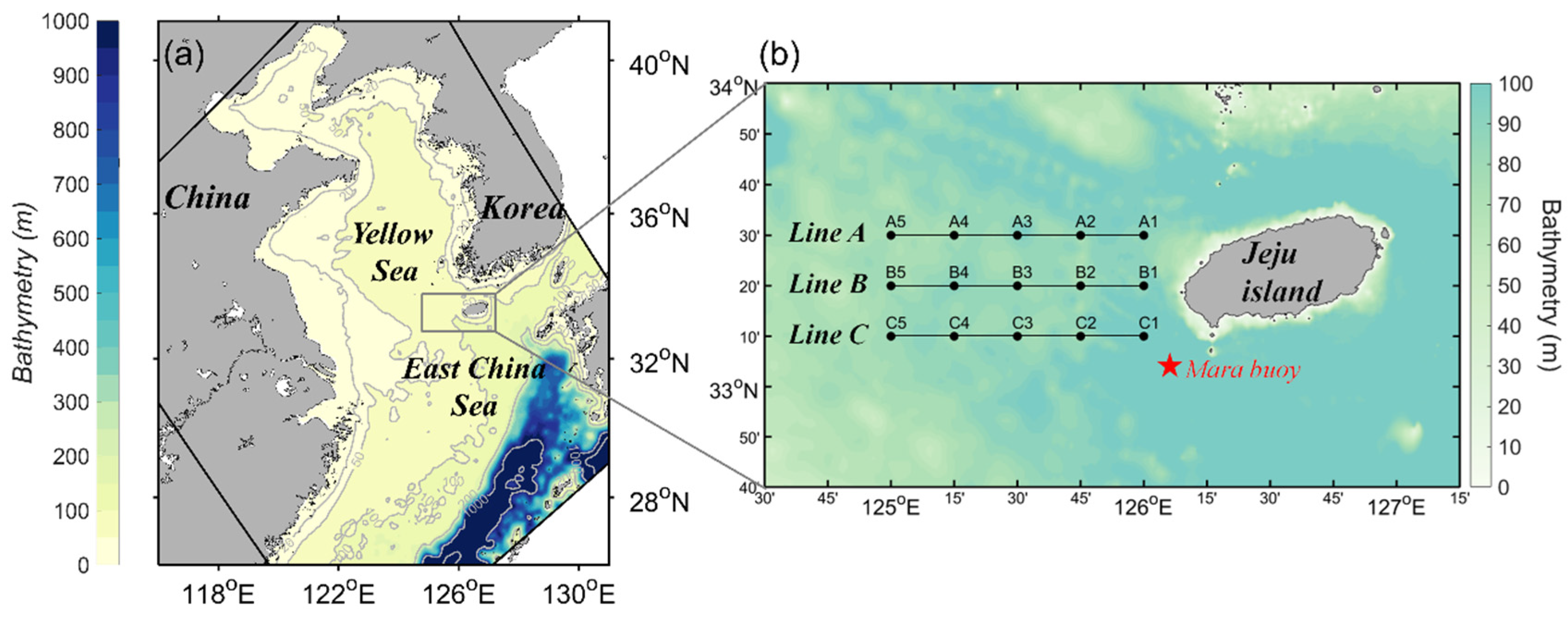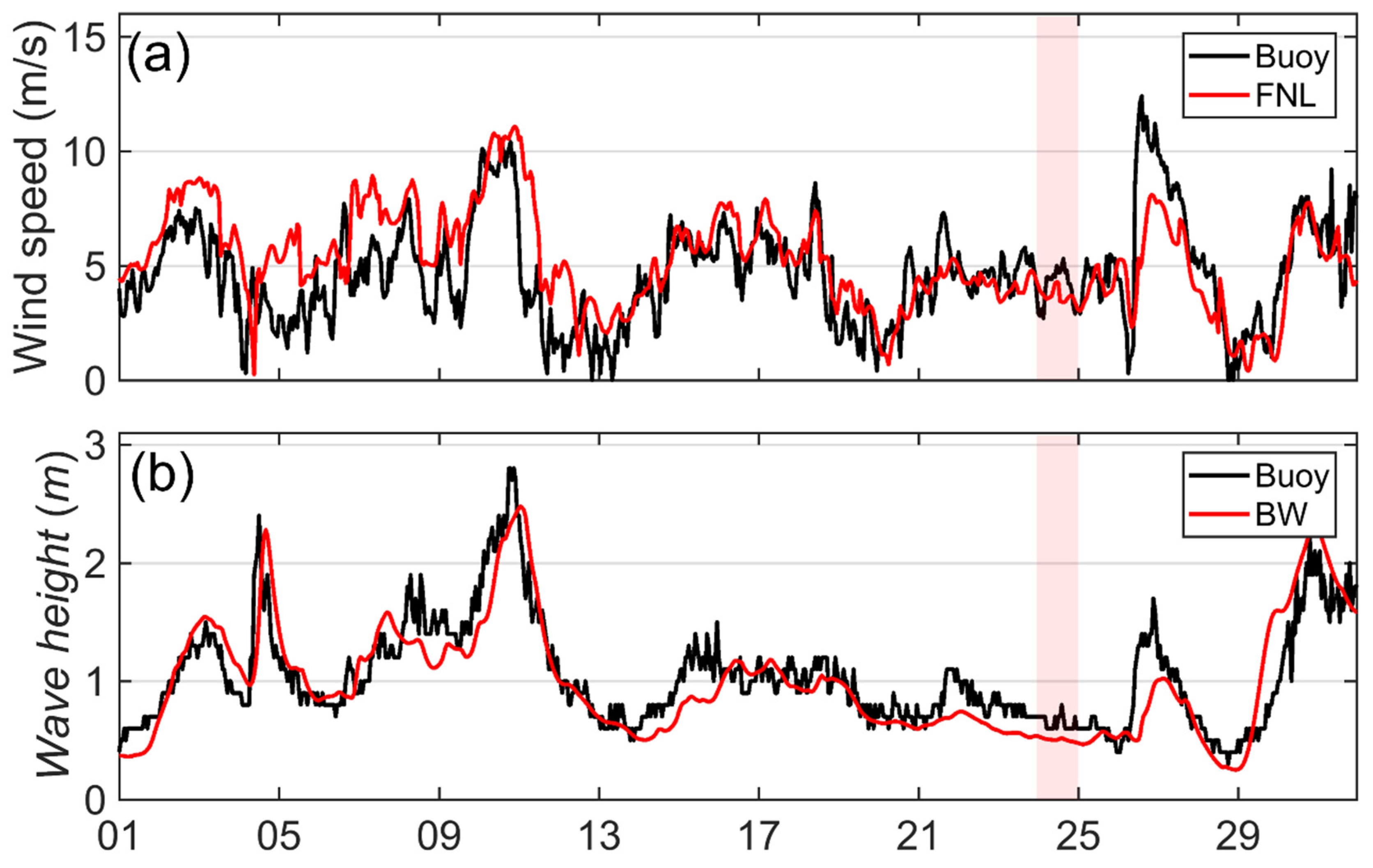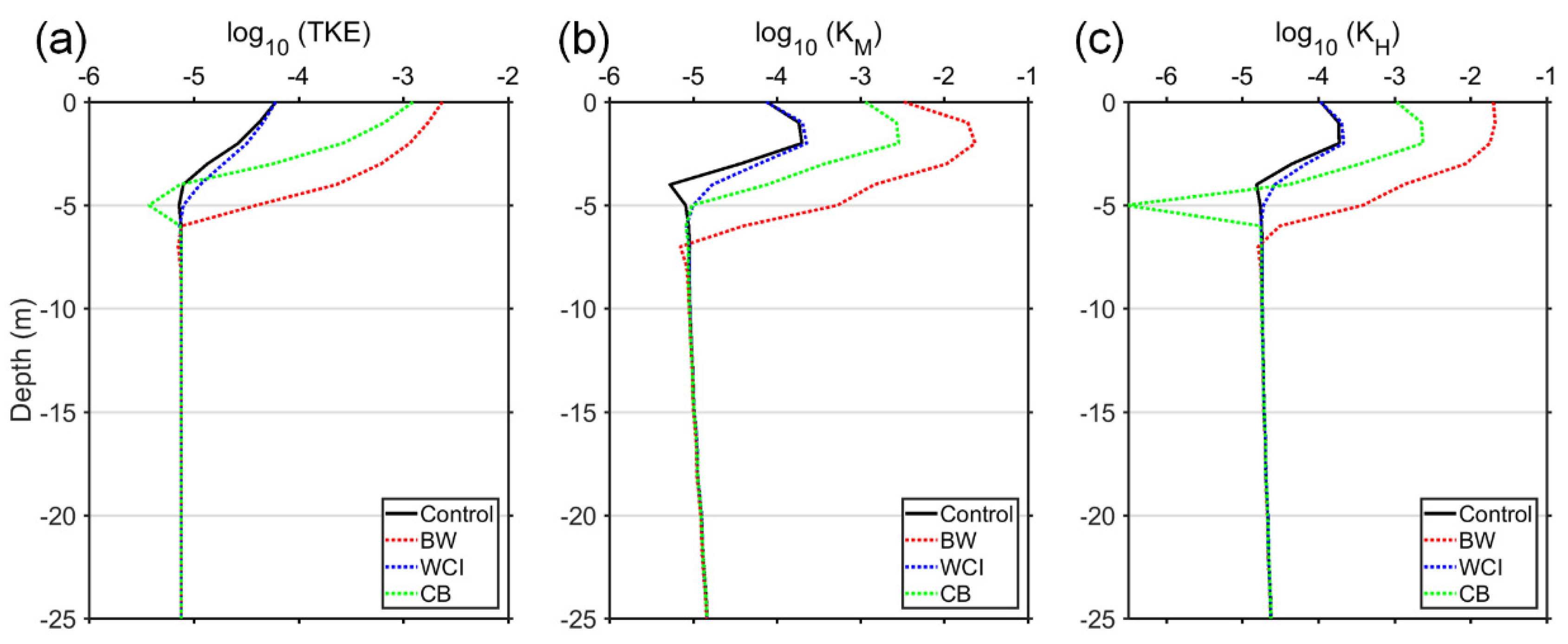Effect of Breaking Waves on Near-Surface Mixing in an Ocean-Wave Coupling System under Calm Wind Conditions
Abstract
1. Introduction
2. Modeling System
2.1. Model Configurations
2.2. Experimental Design
3. Results
3.1. Model Validation
3.2. Effect of Waves on the Ocean-Surface’s Thermal Structure
4. Discussion
4.1. Surface Thermal Mixing Induced by BW
4.2. Effect of Swell-Related BW
5. Summary
Author Contributions
Funding
Acknowledgments
Conflicts of Interest
References
- Lim, S.; Jang, C.J.; Park, J. Climatology of the mixed layer depth in the East/Japan Sea. J. Mar. Syst. 2012, 96, 1–14. [Google Scholar] [CrossRef]
- Rimac, A. The Role of Wind Induced Near-Inertial Waves on the Energetics of the Ocean. Ph.D. Thesis, Universität Hamburg, Hamburg, Germany, 2014. [Google Scholar]
- Qiao, F.; Huang, C.J. Comparison between vertical shear mixing and surface wave-induced mixing in the extratropical ocean. J. Geophys. Res. Ocean. 2012, 117. [Google Scholar] [CrossRef]
- Huang, C.J.; Qiao, F.; Shu, Q.; Song, Z. Evaluating austral summer mixed-layer response to surface wave-induced mixing in the Southern Ocean. J. Geophys. Res. Ocean. 2012, 117. [Google Scholar] [CrossRef]
- Wu, L.; Rutgersson, A.; Sahlée, E. Upper-ocean mixing due to surface gravity waves. J. Geophys. Res. Ocean. 2015, 120, 8210–8228. [Google Scholar] [CrossRef]
- Rascle, N.; Ardhuin, F.; Terray, E.A. Drift and mixing under the ocean surface: A coherent one-dimensional description with application to unstratified conditions. J. Geophys. Res. Ocean. 2006, 111. [Google Scholar] [CrossRef]
- Walsh, K.; Govekar, P.; Babanin, A.V.; Ghantous, M.; Spence, P.; Scoccimarro, E. The effect on simulated ocean climate of a parameterization of unbroken wave-induced mixing incorporated into the k-epsilon mixing scheme. J. Adv. Modeling Earth Syst. 2017, 9, 735–758. [Google Scholar] [CrossRef]
- Wang, Y.; Qiao, F.; Fang, G.; Wei, Z. Application of wave-induced vertical mixing to the K profile parameterization scheme. J. Geophys. Res. Ocean. 2010, 115. [Google Scholar] [CrossRef]
- Song, Z.; Qiao, F.; Song, Y. Response of the equatorial basin-wide SST to non-breaking surface wave-induced mixing in a climate model: An amendment to tropical bias. J. Geophys. Res. Ocean. 2012, 117. [Google Scholar] [CrossRef]
- Bruneau, N.; Toumi, R.; Wang, S. Impact of wave whitecapping on land falling tropical cyclones. Sci. Rep. 2018, 8, 1–11. [Google Scholar] [CrossRef]
- Aijaz, S.; Ghantous, M.; Babanin, A.V.; Ginis, I.; Thomas, B.; Wake, G. Nonbreaking wave-induced mixing in upper ocean during tropical cyclones using coupled hurricane-ocean-wave modeling. J. Geophys. Res. Ocean. 2017, 122, 3939–3963. [Google Scholar] [CrossRef]
- Wada, A.; Niino, H.; Nakano, H. Roles of vertical turbulent mixing in the ocean response to Typhoon Rex (1998). J. Oceanogr. 2009, 65, 373–396. [Google Scholar] [CrossRef]
- Lewis, H.W.; Castillo Sanchez, J.M.; Siddorn, J.; King, R.R.; Tonani, M.; Saulter, A.; Sykes, P.; Pequignet, A.-C.; Weedon, G.P.; Palmer, T.; et al. Can wave coupling improve operational regional ocean forecasts for the north-west European Shelf. Ocean Sci. 2019, 15, 669–690. [Google Scholar] [CrossRef]
- Kantha, L.; Lass, H.U.; Prandke, H. A note on Stokes production of turbulence kinetic energy in the oceanic mixed layer: Observations in the Baltic Sea. Ocean Dyn. 2010, 60, 171–180. [Google Scholar] [CrossRef]
- Paskyabi, M.B.; Fer, I.; Jenkins, A.D. Surface gravity wave effects on the upper ocean boundary layer: Modification of a one-dimensional vertical mixing model. Cont. Shelf Res. 2012, 38, 63–78. [Google Scholar] [CrossRef]
- Kumar, N.; Feddersen, F. The effect of Stokes drift and transient rip currents on the inner shelf. Part II: With stratification. J. Phys. Oceanogr. 2017, 47, 243–260. [Google Scholar] [CrossRef]
- Chune, S.L.; Aouf, L. Wave effects in global ocean modeling: Parametrizations vs. forcing from a wave model. Ocean Dyn. 2018, 68, 1739–1758. [Google Scholar] [CrossRef]
- Craig, P.D.; Banner, M.L. Modeling wave-enhanced turbulence in the ocean surface layer. J. Phys. Oceanogr. 1994, 24, 2546–2559. [Google Scholar] [CrossRef]
- Breivik, Ø.; Mogensen, K.; Bidlot, J.R.; Balmaseda, M.A.; Janssen, P.A. Surface wave effects in the NEMO ocean model: Forced and coupled experiments. J. Geophys. Res. Ocean. 2015, 120, 2973–2992. [Google Scholar] [CrossRef]
- Rascle, N.; Chapron, B.; Ardhuin, F.; Soloviev, A. A note on the direct injection of turbulence by breaking waves. Ocean Model. 2013, 70, 145–151. [Google Scholar] [CrossRef]
- Ardhuin, F.; Orfila, A. Wind waves. New Front. Oper. Oceanogr. 2018, 393–422. [Google Scholar] [CrossRef][Green Version]
- Carniel, S.; Warner, J.C.; Chiggiato, J.; Sclavo, M. Investigating the impact of surface wave breaking on modeling the trajectories of drifters in the northern Adriatic Sea during a wind-storm event. Ocean Model. 2009, 30, 225–239. [Google Scholar] [CrossRef]
- Lie, H.J.; Cho, C.H.; Lee, J.H.; Lee, S.; Tang, Y. Seasonal variation of the Cheju warm current in the northern East China Sea. J. Oceanogr. 2000, 56, 197–211. [Google Scholar] [CrossRef]
- Moon, J.H.; Hirose, N.; Yoon, J.H. Comparison of wind and tidal contributions to seasonal circulation of the Yellow Sea. J. Geophys. Res. Ocean. 2009, 114. [Google Scholar] [CrossRef]
- Yongzeng, Y.; Fangli, Q.; Changshui, X.; Jian, M.; Yeli, Y. Wave-induced mixing in the Yellow Sea. Chin. J. Oceanol. Limnol. 2004, 22, 322–326. [Google Scholar] [CrossRef]
- Huang, D.; Zhang, T.; Zhou, F. Sea-surface temperature fronts in the Yellow and East China Seas from TRMM microwave imager data. Deep Sea Res. Part Ii Top. Stud. Oceanogr. 2010, 57, 1017–1024. [Google Scholar] [CrossRef]
- Warner, J.C.; Armstrong, B.; He, R.; Zambon, J.B. Development of a coupled ocean–atmosphere–wave–sediment transport (COAWST) modeling system. Ocean Model. 2010, 35, 230–244. [Google Scholar] [CrossRef]
- Egbert, G.D.; Erofeeva, S.Y. Efficient inverse modeling of barotropic ocean tides. J. Atmos. Ocean. Technol. 2002, 19, 183–204. [Google Scholar] [CrossRef]
- Fairall, C.W.; Bradley, E.F.; Hare, J.E.; Grachev, A.A.; Edson, J.B. Bulk parameterization of air–sea fluxes: Updates and verification for the COARE algorithm. J. Clim. 2003, 16, 571–591. [Google Scholar] [CrossRef]
- Umlauf, L.; Burchard, H. A generic length-scale equation for geophysical turbulence models. J. Mar. Res. 2003, 61, 235–265. [Google Scholar] [CrossRef]
- Warner, J.C.; Sherwood, C.R.; Arango, H.G.; Signell, R.P. Performance of four turbulence closure models implemented using a generic length scale method. Ocean Model. 2005, 8, 81–113. [Google Scholar] [CrossRef]
- Booij NR, R.C.; Ris, R.C.; Holthuijsen, L.H. A third-generation wave model for coastal regions: 1. Model description and validation. J. Geophys. Res. Ocean. 1999, 104, 7649–7666. [Google Scholar] [CrossRef]
- Madsen, O.S.; Poon, Y.K.; Graber, H.C. Spectral wave attenuation by bottom friction: Theory. In Coastal Engineering 1988; 1989; pp. 492–504. Available online: http://ccrm.vims.edu/yinglong/wiki_files/Manual_SED2D.pdf (accessed on 23 June 2020).
- Battjes, J.A.; Janssen, J.P.F.M. Energy loss and set-up due to breaking of random waves. In Coastal Engineering 1978; 1978; pp. 569–587. Available online: https://icce-ojs-tamu.tdl.org/icce/index.php/icce/article/view/3294 (accessed on 23 June 2020).
- Komen, G.J.; Hasselmann, S.; Hasselmann, K. On the existence of a fully developed wind-sea spectrum. J. Phys. Oceanogr. 1984, 14, 1271–1285. [Google Scholar] [CrossRef]
- Hasselmann, K. On the spectral dissipation of ocean waves due to white capping. Bound. Layer Meteorol. 1974, 6, 107–127. [Google Scholar] [CrossRef]
- Tolman, H.L. A third-generation model for wind waves on slowly varying, unsteady, and inhomogeneous depths and currents. J. Phys. Oceanogr. 1991, 21, 782–797. [Google Scholar] [CrossRef]
- Jacob, R.; Larson, J.; Ong, E. M × N communication and parallel interpolation in Community Climate System Model Version 3 using the model coupling toolkit. Int. J. High Perform. Comput. Appl. 2005, 19, 293–307. [Google Scholar] [CrossRef]
- Larson, J.; Jacob, R.; Ong, E. The model coupling toolkit: A new Fortran90 toolkit for building multiphysics parallel coupled models. Int. J. High Perform. Comput. Appl. 2005, 19, 277–292. [Google Scholar] [CrossRef]
- Kirby, J.T.; Chen, T.M. Surface waves on vertically sheared flows: Approximate dispersion relations. J. Geophys. Res. Ocean. 1989, 94, 1013–1027. [Google Scholar] [CrossRef]
- Moghimi, S.; Thomson, J.; Özkan-Haller, T.; Umlauf, L.; Zippel, S. On the modeling of wave-enhanced turbulence nearshore. Ocean Model. 2016, 103, 118–132. [Google Scholar] [CrossRef]
- Stacey, M.W. Simulation of the wind-forced near-surface circulation in Knight Inlet: A parameterization of the roughness length. J. Phys. Oceanogr. 1999, 29, 1363–1367. [Google Scholar] [CrossRef]
- Charnock, H. Wind stress on a water surface. Q. J. R. Meteorol. Soc. 1955, 81, 639–640. [Google Scholar] [CrossRef]
- Kumar, N.; Voulgaris, G.; Warner, J.C.; Olabarrieta, M. Implementation of the vortex force formalism in the coupled ocean-atmosphere-wave-sediment transport (COAWST) modeling system for inner shelf and surf zone applications. Ocean Model. 2012, 47, 65–95. [Google Scholar] [CrossRef]
- Terray, E.A.; Drennan, W.M.; Donelan, M.A. The vertical structure of shear and dissipation in the ocean surface layer. In The Wind-Driven Air–Sea Interface. Electromagnetic and Acoustic Sensing, Wave Dynamics and Turbulent Fluxes; Banner, M.L., Ed.; School of Mathematics, University of NSW: Sydney, Australia, 1999; pp. 239–245. [Google Scholar]
- Willmott, C.J.; Robeson, S.M.; Matsuura, K. A refined index of model performance. Int. J. Climatol. 2012, 32, 2088–2094. [Google Scholar] [CrossRef]
- Lee, J.H.; Pang, I.C.; Moon, J.H. Contribution of the Yellow Sea bottom cold water to the abnormal cooling of sea surface temperature in the summer of 2011. J. Geophys. Res. Ocean. 2016, 121, 3777–3789. [Google Scholar] [CrossRef]









| Wave Effects on the Ocean | Uncoupled | Coupled | ||
|---|---|---|---|---|
| Control | CB | BW | WCI | |
| Breaking wave | Wind-based parameterization (Equation (3)) | Wave dissipation energy ( in Equation (1) from the wave model) | ||
| Wave-Current interaction | Stokes-Coriolis force, Stokes drift advection, Vortex force (Kumar et al. 2012) | |||
| Bias | RMSE | Correlation | IOA | |
|---|---|---|---|---|
| BW | −0.02 | 0.38 | 0.76 | 0.67 |
| WCI | −0.02 | 0.39 | 0.76 | 0.66 |
© 2020 by the authors. Licensee MDPI, Basel, Switzerland. This article is an open access article distributed under the terms and conditions of the Creative Commons Attribution (CC BY) license (http://creativecommons.org/licenses/by/4.0/).
Share and Cite
Hong, J.-S.; Moon, J.-H.; Kim, T. Effect of Breaking Waves on Near-Surface Mixing in an Ocean-Wave Coupling System under Calm Wind Conditions. J. Mar. Sci. Eng. 2020, 8, 540. https://doi.org/10.3390/jmse8070540
Hong J-S, Moon J-H, Kim T. Effect of Breaking Waves on Near-Surface Mixing in an Ocean-Wave Coupling System under Calm Wind Conditions. Journal of Marine Science and Engineering. 2020; 8(7):540. https://doi.org/10.3390/jmse8070540
Chicago/Turabian StyleHong, Ji-Seok, Jae-Hong Moon, and Taekyun Kim. 2020. "Effect of Breaking Waves on Near-Surface Mixing in an Ocean-Wave Coupling System under Calm Wind Conditions" Journal of Marine Science and Engineering 8, no. 7: 540. https://doi.org/10.3390/jmse8070540
APA StyleHong, J.-S., Moon, J.-H., & Kim, T. (2020). Effect of Breaking Waves on Near-Surface Mixing in an Ocean-Wave Coupling System under Calm Wind Conditions. Journal of Marine Science and Engineering, 8(7), 540. https://doi.org/10.3390/jmse8070540





